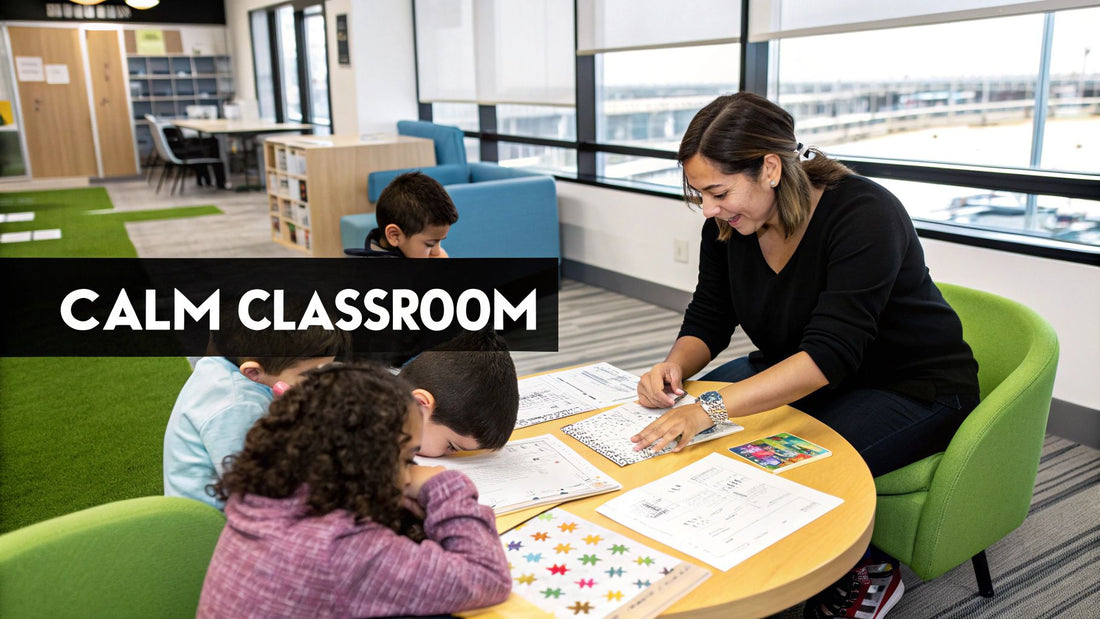
Top Classroom Behaviour Management Strategies for 2025
Share
In today's classrooms, managing behaviour is about more than just maintaining order; it's about nurturing wellbeing. With rising concerns about children's mental health, impacted by everything from social media pressures to the lasting effects of global uncertainty, the need for empathetic and effective classroom behaviour management strategies has never been more critical. Research shows that one in six children aged 5-16 are likely to have a mental health problem, and these challenges often manifest as disruptive behaviour in school.
The cost isn't just academic; untreated mental health issues can lead to significant long-term societal costs, impacting businesses through reduced productivity and increased healthcare needs. This listicle moves beyond traditional discipline to explore nine evidence-based approaches that foster a positive learning environment. To gain a broader understanding of fostering a well-managed learning environment, delve into these essential classroom management strategies. We'll provide practical examples and actionable tips, helping you create a space where every child feels seen, supported, and ready to learn.
It is important to remember, however, that while these strategies are supportive, I am not a mental health professional. If you have serious concerns about a child's mental health, it is vital to seek help from a doctor or a qualified professional.
1. Positive Behaviour Interventions and Supports (PBIS)
Positive Behaviour Interventions and Supports (PBIS) is a proactive, evidence-based framework for creating a positive school climate. Instead of only reacting to misbehaviour, PBIS focuses on teaching and reinforcing positive social, emotional, and academic behaviours. This school-wide system is one of the most effective classroom behaviour management strategies because it builds a supportive culture from the ground up, reducing the need for discipline.
The core of PBIS is its tiered structure, designed to meet the needs of every student. This approach ensures resources are allocated efficiently, providing universal support for all, targeted help for those at risk, and intensive interventions for students with significant needs. This structured system helps prevent behavioural issues before they start and provides clear steps for intervention when they do.
This diagram illustrates the hierarchical three-tiered model of support central to the PBIS framework.
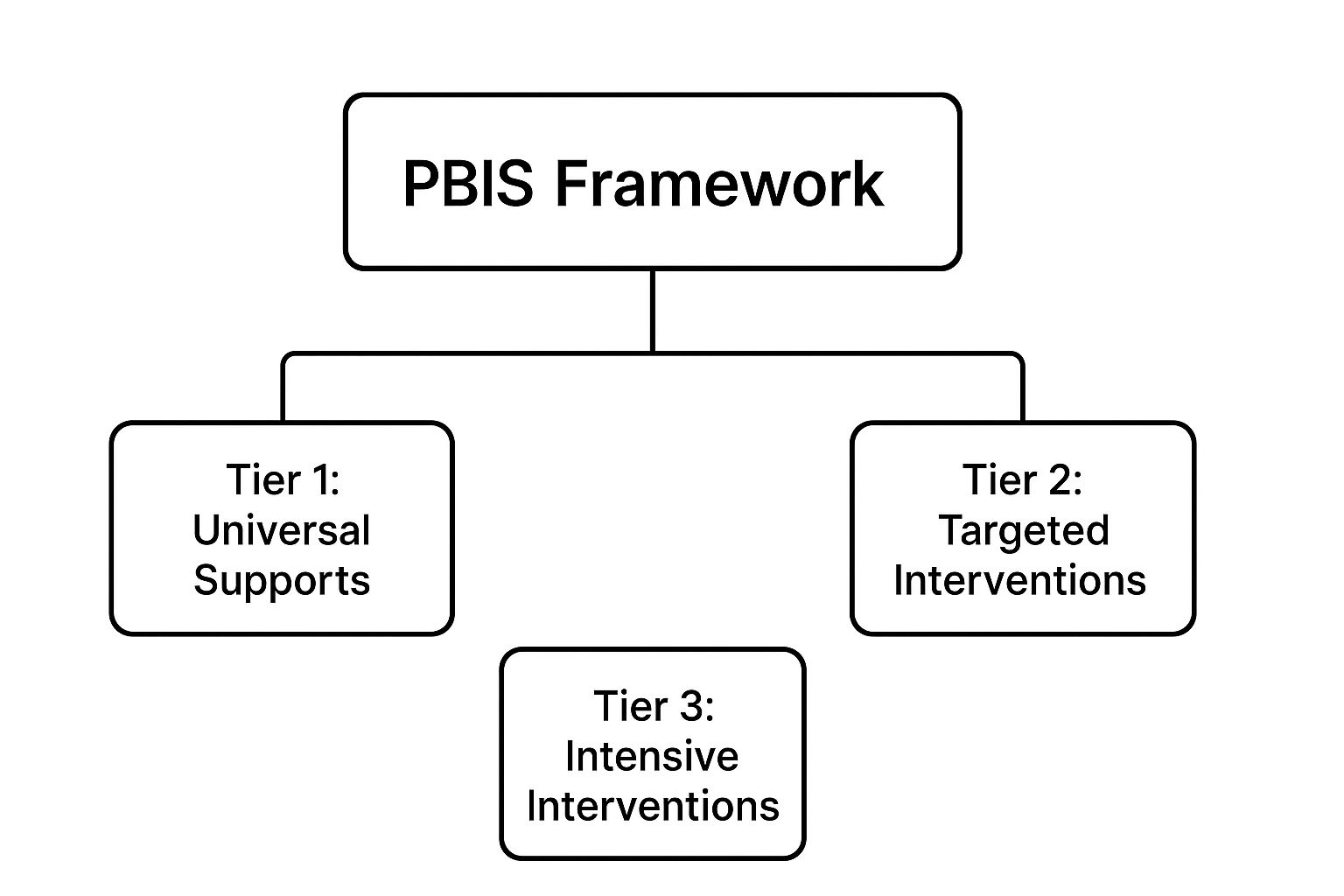
As shown, the framework is built on a foundation of universal supports for everyone, with increasingly focused interventions at Tiers 2 and 3 for smaller groups of students.
How to Implement PBIS
Successfully integrating PBIS requires a committed team and a clear plan. Start by establishing a core leadership group and developing 3-5 simple, positively-stated school-wide expectations, such as "Be Respectful, Be Responsible, Be Safe."
- Teach Explicitly: Treat behavioural expectations like any academic subject. Dedicate time to teach, model, and practise them in all settings, from the classroom to the playground. For instance, 'Being Respectful' in the corridor means walking quietly and keeping hands to yourself; practise this by having pupils walk the corridor correctly.
- Acknowledge Positivity: Actively look for students meeting expectations and acknowledge their behaviour. Aim for a ratio of at least four positive interactions for every one corrective interaction.
- Use Data: Collect and analyse behaviour data to identify patterns and make informed decisions. This allows your team to adjust strategies and provide support where it's needed most.
- Gain Support: Ensure you have strong backing from school administration, as this is crucial for long-term success.
2. Responsive Classroom Approach
The Responsive Classroom approach is an evidence-based method that merges social and emotional learning with academic instruction. It focuses on creating a positive classroom community where pupils feel safe, challenged, and joyful. This student-centred approach uses specific teaching practices to foster engagement, self-control, and a sense of belonging, making it one of the most effective classroom behaviour management strategies for building a cohesive learning environment.
At its core, the Responsive Classroom approach is built on the belief that how children learn is as important as what they learn. Practices like the Morning Meeting, collaborative rule creation, and interactive modelling help build a strong community from the first day of school. This proactive focus on relationships and social skills helps prevent behavioural issues by addressing pupils' underlying needs for significance and connection.
This image highlights a teacher using interactive modelling, a key practice in the Responsive Classroom approach, to demonstrate expectations clearly.
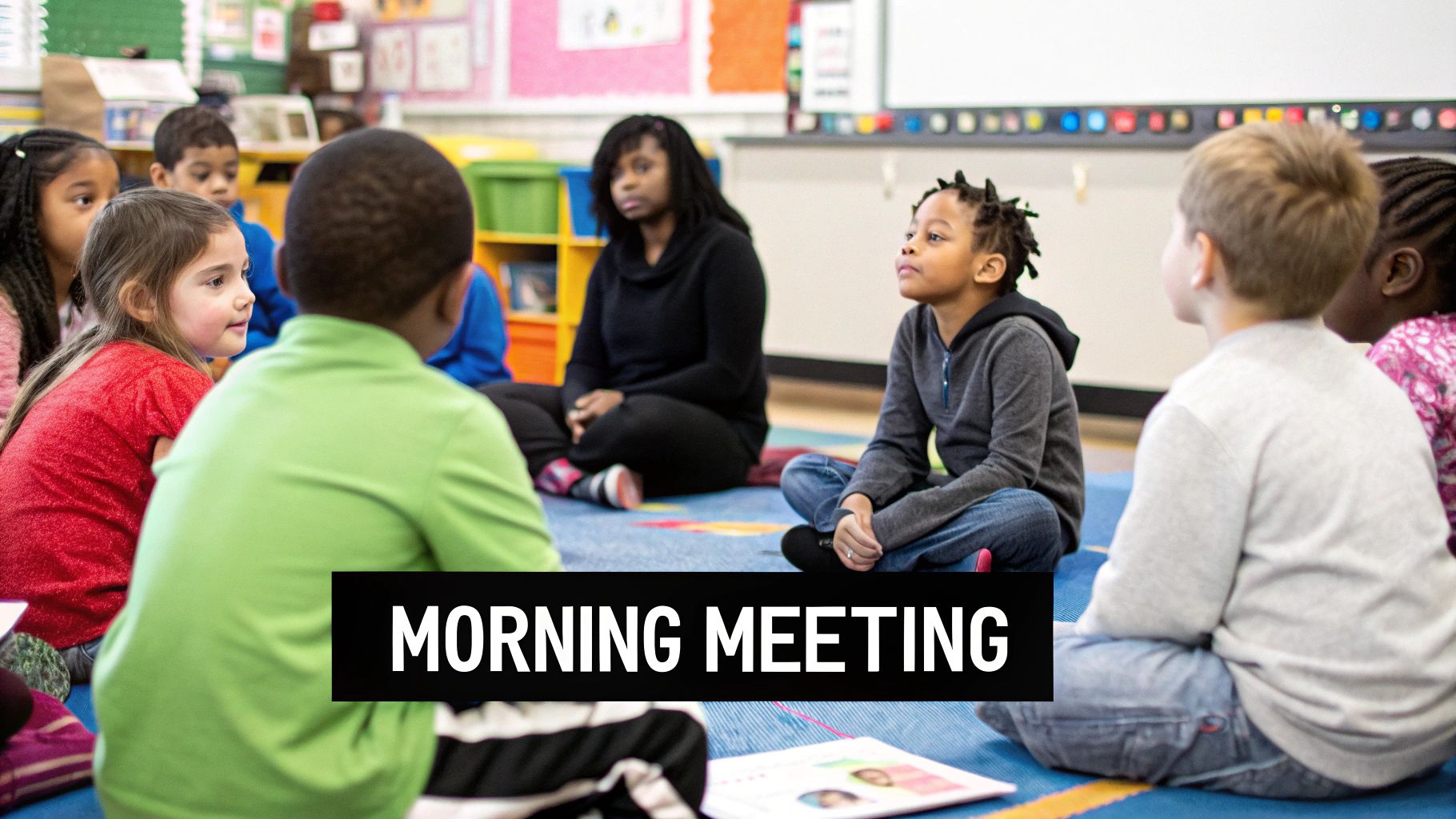
As shown, the technique involves showing students exactly what to do, creating a clear and positive model for expected behaviour.
How to Implement the Responsive Classroom Approach
Implementing this approach requires a commitment to building community and teaching social skills alongside academics. A great starting point is establishing a daily Morning Meeting to build a routine of respectful interaction.
- Establish Routines: Dedicate the first six weeks of school to teaching and reinforcing classroom routines and procedures using interactive modelling.
- Create Rules Collaboratively: Involve pupils in creating classroom rules during the first weeks. For example, instead of a rule like "No shouting," pupils might suggest "Use indoor voices," which gives them ownership and a deeper understanding of the expectations.
- Use Positive Language: Intentionally use reinforcing language (e.g., “I noticed you worked together to solve that problem”) and reminding language (e.g., “What should you be doing while waiting?”) to guide behaviour.
- Start Small: Begin by implementing one or two core practices, like the Morning Meeting or interactive modelling, and gradually incorporate more as you become comfortable.
3. Class Dojo and Token Economy Systems
Token economy systems are a behaviourist-based strategy where pupils earn tokens or points for demonstrating desired behaviours, which can then be exchanged for rewards. This approach provides immediate, tangible reinforcement for positive actions. Modernised digital platforms like Class Dojo, popularised by co-founders Sam Chaudhary and Liam Don, streamline this process, allowing teachers to award points in real-time and communicate effortlessly with families.
These systems are effective classroom behaviour management strategies because they make expectations clear and provide consistent positive feedback. When pupils see a direct link between their actions and a reward, whether it’s extra free time or a positive note home, they are more motivated to self-regulate their behaviour. This structured reinforcement helps build positive habits that can become intrinsic over time.
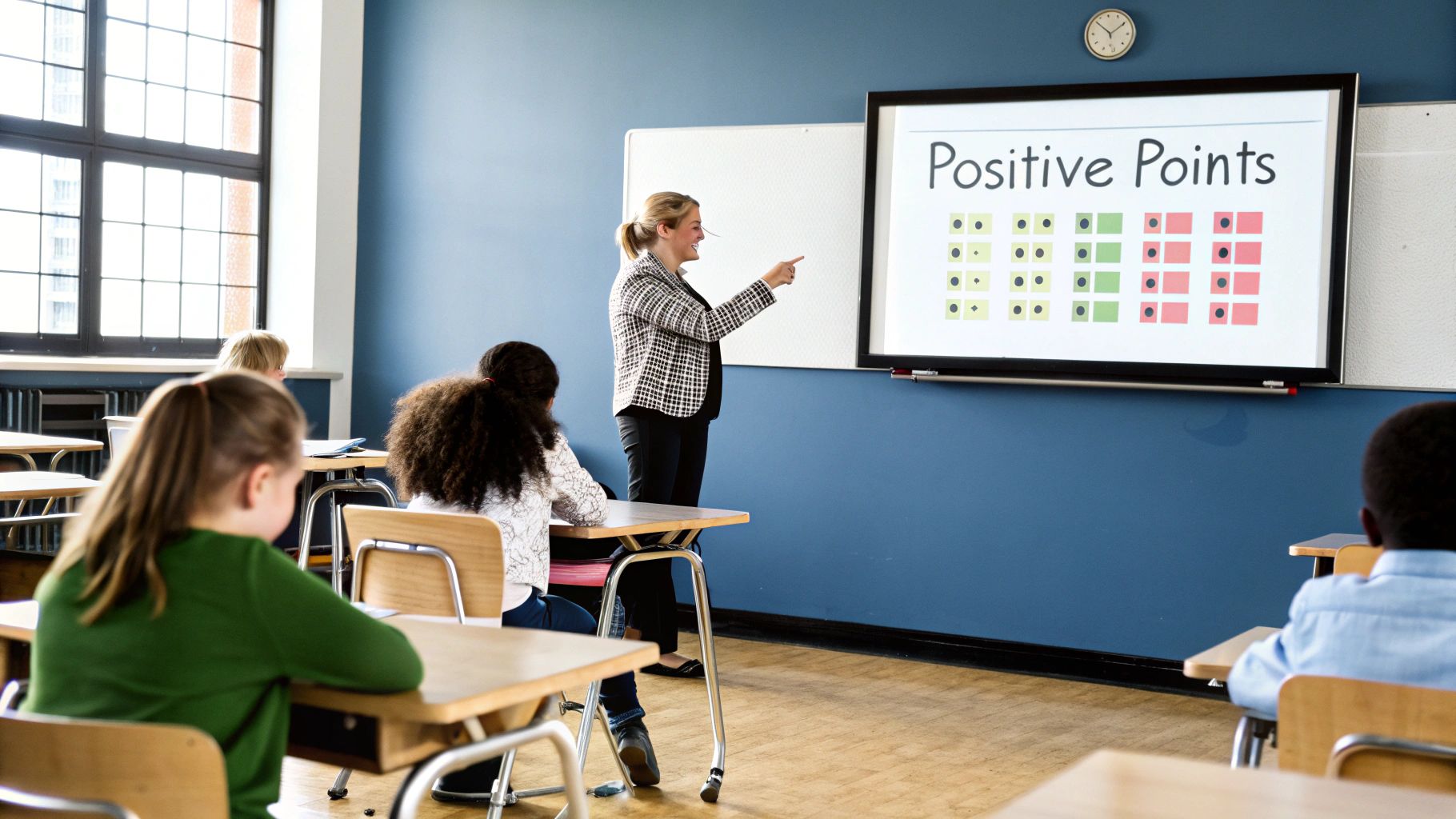
The visual nature of platforms like Class Dojo helps children, especially younger learners, to understand and track their progress, fostering a sense of accomplishment and ownership over their actions.
How to Implement a Token Economy
To create an effective system, collaboration and clarity are essential. Involve pupils in deciding which rewards are most meaningful to them to increase buy-in and motivation.
- Define Clear Behaviours: Explicitly teach, model, and practise the specific behaviours that earn points, such as "using kind words" or "staying on task."
- Maintain a Positive Ratio: Focus on awarding points for positive actions. Aim for at least a 5:1 ratio of positive reinforcement to corrective feedback to keep the classroom climate supportive.
- Combine Individual and Group Goals: Set goals for individual pupils and for the whole class. This encourages both personal responsibility and collaborative effort, such as working together for a class-wide reward like extra playtime.
- Communicate with Families: Use the system to share positive achievements with parents. Class Dojo's communication features can dramatically improve the home-school connection, creating a consistent support network for the child.
4. Restorative Justice Practices
Restorative Justice in education is a powerful philosophy focused on repairing harm and rebuilding relationships rather than simply punishing misbehaviour. Instead of asking what rule was broken, this approach asks who was harmed and what must be done to make things right. As a classroom behaviour management strategy, it shifts the focus from punishment to accountability, empathy, and community, fostering a safer and more connected learning environment. This process helps pupils understand the real-world impact of their actions and empowers them to take responsibility for resolving conflicts.
This approach builds a strong sense of community, where pupils feel seen and heard.
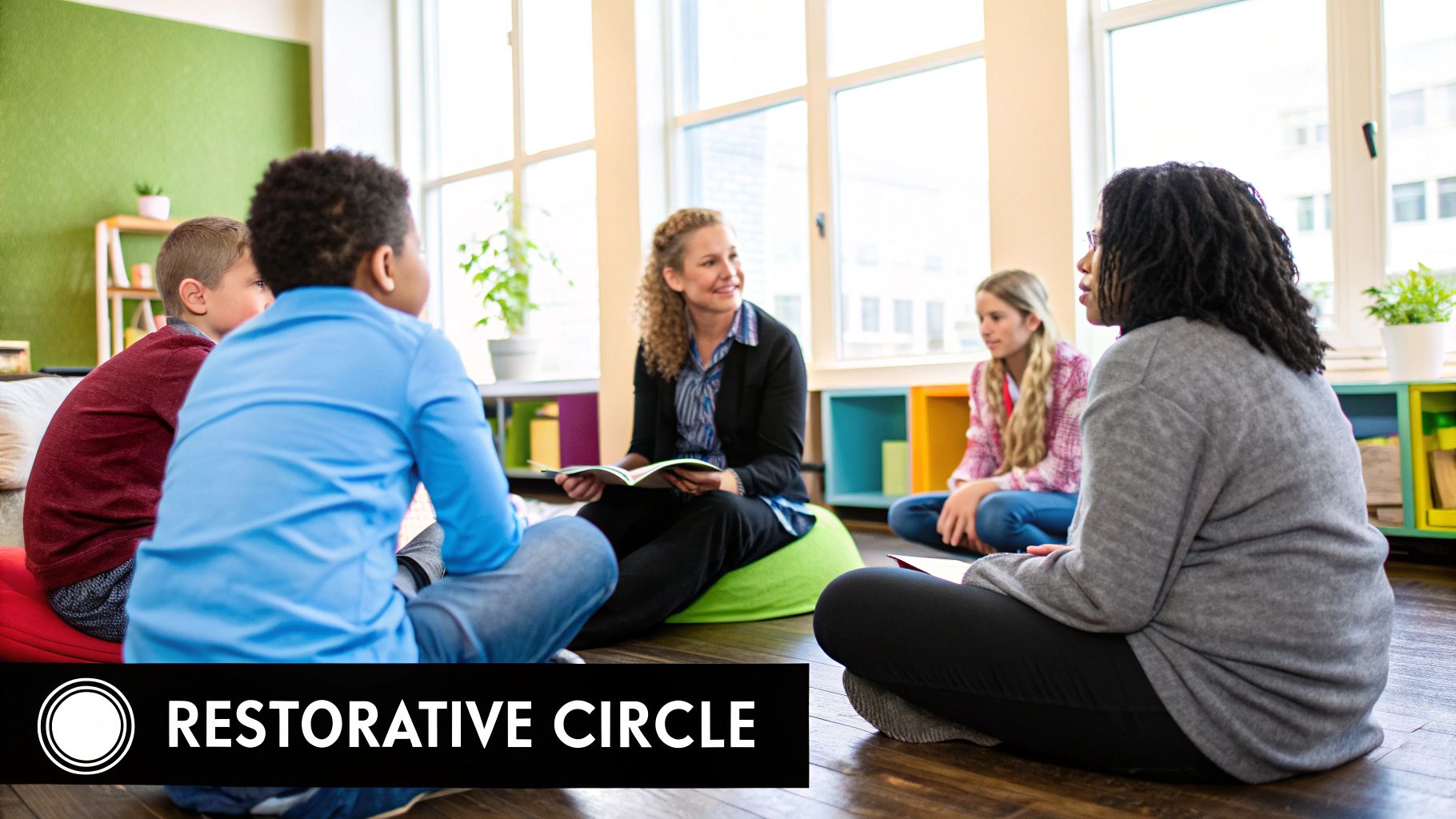
By prioritising dialogue and mutual understanding, restorative practices address the root causes of behaviour, promoting long-term change. Many schools have seen remarkable success; for instance, some UK councils have reported significant reductions in exclusions after implementing these methods in schools.
How to Implement Restorative Justice Practices
Integrating restorative practices begins with building a strong classroom community before conflicts arise. This proactive foundation makes it easier to address harm when it occurs.
- Start with Circles: Use proactive community-building circles regularly. Daily check-ins where pupils share highs and lows can build the trust needed to handle difficult conversations later. For example, a simple question like, "What is one good thing that happened this morning?" can start the day on a positive, connected note.
- Establish Guidelines: Create clear guidelines for circles, such as respecting confidentiality, listening actively, and using a "talking piece" to ensure everyone has an uninterrupted chance to speak.
- Ask Restorative Questions: When conflict occurs, guide the conversation with open-ended questions: What happened? Who has been affected? What needs to happen to make things right?
- Seek Training: To implement these practices effectively and safely, seek proper training from experienced restorative justice practitioners. This approach aligns closely with trauma-informed teaching, which recognises and responds to the impact of trauma on children's well-being. Learn more about trauma-informed care.
5. The 5:1 Positive-to-Negative Interaction Ratio
The 5:1 ratio is a powerful classroom behaviour management strategy grounded in psychological research. It proposes that for every one corrective or negative interaction a teacher has with a pupil, there should be at least five positive ones. This concept, popularised in education by researchers like Dr. Paul Caldarella and Dr. Randy Sprick, builds a foundation of trust and mutual respect, making pupils more receptive to guidance when correction is necessary.
This strategy transforms the classroom climate by intentionally focusing on what pupils are doing right. Positive interactions can range from specific praise and non-verbal cues like a smile or thumbs-up, to acknowledging effort and showing genuine interest in a pupil’s well-being. By consistently creating a positive relational balance, educators foster a supportive environment where pupils feel valued, which is crucial for their emotional and academic development.
How to Implement the 5:1 Ratio
Integrating this ratio requires conscious effort and a commitment to building relationships. Begin by tracking your interactions to establish a baseline before aiming for the 5:1 goal.
- Be Specific with Praise: Instead of a generic "good job," offer behaviour-specific praise that reinforces expectations. For example, say, "Thank you for raising your hand and waiting patiently; that shows great respect for your classmates."
- Greet Pupils Individually: Start each day or lesson on a positive note by greeting every pupil at the door with a smile and a brief, personal comment. This simple act can set a positive tone for the entire class.
- Track Your Interactions: Initially, use a clicker counter, a tally sheet, or even transfer coins from one pocket to another to monitor your positive interactions. This helps build the habit of seeking out positive behaviours to acknowledge.
- Make Positive Connections Home: A short, positive phone call or note home can have a dramatic impact. Highlighting a pupil's success or improved effort strengthens the home-school partnership and builds significant goodwill.
6. Zones of Regulation
The Zones of Regulation is a powerful cognitive-behavioural framework designed to teach pupils emotional control and self-regulation. Instead of viewing behaviour as simply "good" or "bad", this approach categorises feelings and states of alertness into four distinct coloured zones. This systematic method helps children visualise and understand their internal states, making it one of the most effective classroom behaviour management strategies for developing emotional intelligence.
Developed by occupational therapist Leah Kuypers, the framework empowers pupils to identify their feelings and provides a toolkit of strategies to manage them. The goal is not to stay in the "Green Zone" (calm and focused) constantly, but to recognise all zones are natural and to develop healthy coping mechanisms. This proactive approach helps prevent emotional escalations and builds foundational skills for lifelong well-being, which is crucial given the rising concerns around children's mental health.
How to Implement Zones of Regulation
Integrating the Zones of Regulation requires a consistent, whole-class approach where emotional literacy is taught explicitly. Start by introducing the four zones one at a time, using visual aids and activities to explore the feelings associated with each.
- Create a Zones Check-In: Designate a space in the classroom where pupils can non-verbally indicate their current zone, for instance, by moving a name clip on a poster. This gives you a quick emotional snapshot of your class.
- Develop Personal Toolkits: Work with pupils to create individualised toolboxes of strategies that help them regulate. These might include fidget toys, breathing exercises, or quiet time passes. A pupil feeling in the 'Yellow Zone' (anxious) might use a stress ball from their toolkit before a test. To further support this, exploring various mindfulness activities for self-regulation can provide excellent tools.
- Model and Normalise: Regularly model your own feelings and regulation strategies. Saying, "I'm feeling a bit in the Yellow Zone because the computer is slow, so I'm going to take three deep breaths," normalises the experience for pupils.
- Use Consistent Language: Employ consistent, non-judgemental language school-wide, such as "I can see you're in the Red Zone. What tool could help?" This shared vocabulary creates a supportive and predictable environment.
7. Premack Principle (Grandma's Rule)
The Premack Principle, often called ‘Grandma’s Rule’, is a straightforward yet powerful behavioural strategy. It uses a highly preferred activity to reinforce a less preferred one. The core idea is simple: “First you do the task you need to do, then you get to do the task you want to do.” This makes it one of the most practical classroom behaviour management strategies because it relies on existing motivators rather than needing external rewards.
This approach, formalised by psychologist David Premack, is effective because it links the completion of a necessary, low-probability behaviour (like a maths worksheet) with immediate access to a rewarding, high-probability behaviour (like free reading time). It teaches pupils the value of completing tasks and helps build self-regulation skills. By structuring tasks this way, educators can guide pupils towards completing their work in a positive and encouraging manner.
This video provides a clear explanation of how the Premack Principle works in a classroom setting.
As demonstrated, this simple 'first-then' structure can be adapted for any age group, from cleaning up blocks in nursery to finishing lab reports in secondary school.
How to Implement the Premack Principle
To use this strategy effectively, you need to understand what motivates your pupils and apply the principle consistently. The goal is to create a positive contingency, not a threat.
- Identify Motivators: Observe pupils to learn what activities they genuinely enjoy. This could be anything from computer time to helping a classmate or choosing a story.
- Frame it Positively: Use "When/then" language instead of "If/then". For example, say, "When you have finished your writing, then you can use the iPad," rather than, "If you don't finish your writing, you won't get the iPad."
- Be Consistent: For the principle to work, you must always follow through. The preferred activity must reliably follow the completion of the non-preferred task.
- Use Visuals: For younger pupils or those with communication challenges, a visual ‘First-Then’ board with pictures can be highly effective at clarifying expectations and reducing anxiety. For example, a picture of a worksheet followed by a picture of a toy car.
8. Classroom Routines and Procedures with Explicit Teaching
Establishing clear, consistent routines is a cornerstone of effective classroom behaviour management strategies. This approach involves defining procedures for every classroom activity, from entering the room to handing in work, and then explicitly teaching them as you would any academic subject. Popularised by educators like Dr. Harry Wong, this method prevents misbehaviour by removing ambiguity and helping pupils understand exactly what is expected of them at all times.
The core principle is that much disruptive behaviour stems from uncertainty, not defiance. When pupils internalise procedures, the classroom runs smoothly and efficiently, freeing up significant time for learning. This proactive strategy creates a predictable and secure environment, which is crucial for pupils' emotional well-being and academic focus. It helps build a sense of community and shared responsibility, making the classroom a well-organised space for everyone.
How to Implement Classroom Routines and Procedures
Implementing this strategy effectively requires planning and consistency, especially at the start of the school year or after a break. Begin by identifying the 5-8 most critical procedures that will have the biggest impact on your classroom's flow.
- Explain, Model, and Practise: Use an explicit instruction model. First, explain the procedure and why it's important. Second, model exactly how to do it. Finally, have pupils practise the routine multiple times while you provide specific feedback.
- Use Visual Reminders: Post simple, clear visual aids or charts for key procedures, especially for younger learners. This helps reinforce expectations without constant verbal reminders.
- Acknowledge and Reinforce: When you see pupils following procedures correctly, acknowledge it. A simple "I see everyone has their materials ready, great job" reinforces the desired behaviour for the whole class.
- Be Consistent: Your own consistency is paramount. By following the procedures yourself, you model their importance and show pupils they are a non-negotiable part of the classroom culture. This structured approach also supports the development of pupils' self-regulation, a key aspect of their broader social-emotional learning. To learn more about how routines foster these skills, you can explore social-emotional learning on thatsokay.co.uk.
9. Check-In/Check-Out (CICO) System
The Check-In/Check-Out (CICO) system, also known as the Behaviour Education Programme (BEP), is a highly structured intervention for pupils needing more support than universal classroom management strategies provide. It is a cornerstone of Tier 2 support within a PBIS framework, designed for pupils who exhibit persistent, low-level challenging behaviours but do not require intensive, individualised intervention. CICO offers these pupils increased adult attention, frequent feedback, and a consistent routine, fostering a stronger home-school connection.
This system provides a predictable structure that helps pupils develop self-regulation and accountability. At the beginning of each day, the pupil checks in with a designated adult to receive a point card with specific, positive behavioural goals. Throughout the day, teachers provide feedback on the card, and the pupil checks out with their mentor to review progress before taking the card home for a parent's signature. This daily loop of feedback and reinforcement is one of the most practical classroom behaviour management strategies for promoting positive change.
How to Implement a CICO System
A successful CICO programme requires careful organisation and consistent application from all staff involved. The focus should be on building positive relationships and celebrating small wins to build momentum for the pupil.
- Establish Clear Goals: Work with the pupil to set 2-3 clear, measurable, and positively-phrased behavioural goals, such as "Follow directions promptly" or "Stay on task."
- Train All Staff: Ensure every adult who will interact with the pupil's CICO card, from teachers to the designated mentor, understands the procedure, their role, and the importance of positive reinforcement.
- Maintain Consistency: The check-in and check-out process must happen at the same time and in the same way every day to build a reliable routine. Data must be collected consistently to track progress accurately.
- Communicate with Parents: Regularly communicate with parents or caregivers about their child's progress. The daily report card is a key tool for creating a supportive partnership between home and school.
- Plan for Fading: As the pupil consistently meets their goals and demonstrates improved skills, gradually reduce the level of support to foster independence.
Classroom Behaviour Strategies Comparison Matrix
| Item | Implementation Complexity 🔄 | Resource Requirements ⚡ | Expected Outcomes 📊 | Ideal Use Cases 💡 | Key Advantages ⭐ |
|---|---|---|---|---|---|
| Positive Behaviour Interventions and Supports (PBIS) | High - requires extensive training, 3-5 years for fidelity | High - dedicated staff time, funding, data systems | Significant reduction in behavioural issues, improved climate & academics | Whole-school systems, multi-tiered support | Evidence-based, proactive, tiered interventions, strong research base |
| Responsive Classroom Approach | Moderate - upfront routine building & daily meetings | Moderate - time investment, training needed | Strong classroom community, increased engagement | Primary classrooms, SEL integration | Builds intrinsic motivation, develops self-regulation, adaptable |
| Class Dojo and Token Economy Systems | Low to moderate - tech setup and ongoing management | Low to moderate - requires devices & tech support | Immediate behaviour reinforcement, increased parent engagement | Classrooms focusing on behaviour tracking & tech engagement | Real-time feedback, parent communication, gamification motivate pupils |
| Restorative Justice Practices | High - intensive training, skilled facilitation needed | Moderate to high - staff training, time for circles | Reduced exclusions, improved relationships, empathy development | Schools aiming to reduce exclusion & build community | Addresses root causes, builds empathy, reduces disparities |
| The 5:1 Positive-to-Negative Interaction Ratio | Low - requires consistent conscious effort | Very low - no special materials needed | Improved classroom climate, increased pupil motivation | Universal application across all year groups | Simple, cost-free, strengthens relationships, reduces teacher burnout |
| Zones of Regulation | Moderate - requires explicit instruction and materials | Moderate - curriculum, posters, training | Improved self-regulation and emotional awareness | Pupils with emotional regulation needs, broad K-12 use | Common emotional language, proactive strategies, visual supports |
| Premack Principle (Grandma's Rule) | Low - simple to understand and implement | Very low - uses existing activities and motivators | Increased task completion using natural reinforcers | Individual behaviour support across settings | Uses natural motivators, no cost, reinforces delayed gratification |
| Classroom Routines and Procedures with Explicit Teaching | Moderate - significant initial teaching & practice | Low to moderate - visual aids and teacher time | Increased instructional time, fewer behavioural disruptions | All classrooms, especially supporting self-regulation challenges | Clear expectations, predictable environment, improves instructional focus |
| Check-In/Check-Out (CICO) System | Moderate - training and daily coordination required | Moderate - staff time for check-ins, data tracking | Reduced problem behaviours, increased adult/pupil engagement | Tier 2 intervention for at-risk pupils | Structured feedback, parent involvement, flexible & efficient |
Your Next Steps in Building a Positive Classroom Culture
Navigating the landscape of classroom behaviour is a dynamic and ongoing process. The nine classroom behaviour management strategies detailed in this article, from the proactive framework of PBIS to the individualised support of a Check-In/Check-Out system, are not standalone solutions. Instead, they represent a toolkit of interconnected approaches designed to build a foundation of trust, respect, and emotional safety. The most effective classrooms are not those free of challenges, but those where challenges are met with empathy, structure, and a consistent, supportive response.
The core thread weaving through all these methods is a fundamental shift in perspective: moving from reactive punishment to proactive teaching. Whether implementing restorative justice circles to repair harm or using the Zones of Regulation to build emotional literacy, you are teaching vital life skills. You are showing pupils that their feelings are valid and that they can develop the capacity to manage their responses in constructive ways. This approach honours the whole child, acknowledging that behaviour is often a communication of an unmet need.
Key Takeaways for Lasting Impact
As you reflect on these strategies, keep these central principles in mind:
- Consistency is Crucial: The success of any system, be it a token economy or clearly defined classroom routines, hinges on consistent application. Predictability creates a sense of safety for pupils, allowing them to understand expectations and thrive within them.
- Relationships are the Foundation: Techniques like the 5:1 ratio are not just about numbers; they are about intentionally building positive connections. A strong teacher-pupil relationship is the single most powerful tool in your behaviour management toolkit.
- Empowerment Over Control: The ultimate goal is to foster self-regulation. Strategies like the Premack Principle and the Responsive Classroom approach empower pupils to make positive choices, giving them ownership over their learning and behaviour.
Actionable Next Steps for Educators and Caregivers
Transforming theory into practice requires intentional action. Here are some steps you can take today:
- Start Small: Choose just one or two strategies that resonate with you and your pupils' needs. Perhaps you can begin by explicitly teaching one new classroom procedure or consciously tracking your positive-to-negative interactions for a week.
- Prioritise Your Wellbeing: Managing a classroom is demanding work. The impact of stress on adults is significant, and your emotional state directly influences the classroom climate. Explore personal relaxation tips like mindfulness exercises or deep-breathing techniques to stay centred.
- Normalise Mental Health Conversations: Create a culture where it is safe to talk about feelings. You can subtly champion this by wearing mental health apparel with a positive message or having accessible mental health books in your classroom library. These small acts reduce stigma and build a community of care.
Remember, your dedication to implementing effective classroom behaviour management strategies does more than just create an orderly learning environment. It builds a supportive ecosystem where every child feels seen, heard, and valued. You are equipping them with the emotional and social tools they need to succeed, not just academically, but in life. While these strategies are powerful, it is vital to recognise the signs of more significant mental health challenges. If you are ever seriously worried about a child's wellbeing, please consult a GP or a qualified mental health professional for guidance.
Ready to enhance your classroom's emotional literacy? Explore the curated selection of mental health books and resources at Little Fish Books. Our engaging stories and activities are designed to complement strategies like the Zones of Regulation, helping children understand and express their feelings in a healthy way. Visit Little Fish Books to discover tools that build empathy and resilience in your learning community.
